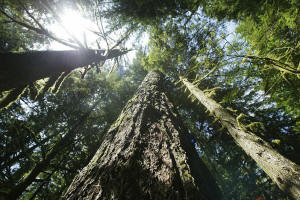More logging is proposed to help curb wildfires in the US Pacific
Northwest
 Send a link to a friend
Send a link to a friend
 [November 18, 2024] By
MATTHEW BROWN [November 18, 2024] By
MATTHEW BROWN
U.S. officials would allow increased logging on federal lands across the
Pacific Northwest in the name of fighting wildfires and boosting rural
economies under proposed changes to a sweeping forest management plan
that’s been in place for three decades.
The U.S. Forest Service proposal, released Friday, would overhaul the
Northwest Forest Plan that governs about 38,000 square miles (99,000
square kilometers) in Oregon, Washington and California.
The plan was adopted in 1994 under President Bill Clinton amid pressure
to curb destructive logging practices that resulted in widespread
clearcuts and destroyed habitat used by spotted owls. Timber harvests
dropped dramatically in subsequent years, spurring political backlash.
But federal officials now say worsening wildfires due to climate change
mean forests must be more actively managed to increase their resiliency.
Increased logging also would provide a more predictable supply of trees
for timber companies, officials said, helping rural economies that have
suffered after lumber mills shut down and forestry jobs disappeared.
The proposal could increase annual timber harvests by at least 33% and
potentially more than 200%, according to a draft environmental study.
The number of timber-related jobs would increase accordingly.

Harvest volumes from the 17 national forests covered by the Northwest
Forest Plan averaged about 445 million board feet annually over the past
decade, according to government figures.
Cutting more trees would help reduce wildfire risk and make communities
safer, the study concluded. That would be accomplished in part by
allowing cuts in some areas with stands of trees up to 120 years old —
up from the current age threshold of 80 years.
The change could help foster conditions conducive to growing larger, old
growth trees that are more resistant to fire, by removing younger trees,
officials said.
A separate pending proposal from President Joe Biden's administration
aims to increase protections nationwide for old growth trees, which play
a significant role in storing climate change-inducing carbon dioxide.
“Much has changed in society and science since the Northwest Forest Plan
was created,” Jacque Buchanan, regional forester for the Forest
Service’s Pacific Northwest Region, said in a statement. He said the
proposal would help the agency adapt to shifting conditions, as global
warming increases the frequency of droughts and other extreme weather
events.
[to top of second column] |

Old-growth Douglas fir trees stand along the Salmon River Trail,
June 25, 2004, in Mt. Hood National Forest outside Zigzag, Ore. (AP
Photo/Rick Bowmer, File)
 The proposed plan also calls for
closer cooperation between the Forest Service and Native American
tribes to tap into tribal knowledge about forest management. Tribes
were excluded when the 1994 plan was crafted.
Environmentalists greeted the proposal with skepticism. The group
Oregon Wild said it was “deeply troubling” that the Forest Service
would release the proposal just ahead of a change in presidential
administrations.
“It appears that the Forest Service wants to abandon the fundamental
purpose of the Northwest Forest Plan–protecting fish and wildlife
and the mature and old-growth forests they need to survive,” John
Persell, an attorney for the group, said in a statement.
During former President Donald Trump’s first term, administration
officials sought to open millions of acres of West Coast forest to
new logging by stripping habitat protections for the imperiled
spotted owl. The move was opposed by government biologists and
reversed under Biden.
A draft environmental study examined several potential alternatives,
including leaving the existing plan’s components in place or
changing them to either reduce or increase logging.
A timber industry representative who co-chaired an advisory
committee on the Northwest Forest Plan said the proposed plan
resulted from discussions involving committee members, the Forest
Service and others.
“We want to see a modern approach to federal forest stewardship that
protects us from catastrophic wildfires, reduces toxic smoke,
meaningfully engages tribes, and delivers for our rural communities
and workers,” said Travis Joseph, president of the American Forest
Resource Council.
The publishing of the proposal begins a 120-day public comment
period. The Forest Service's environmental review is expected to be
completed by next fall and a final decision is due in early 2026.
All contents © copyright 2024 Associated Press. All rights reserved
 |